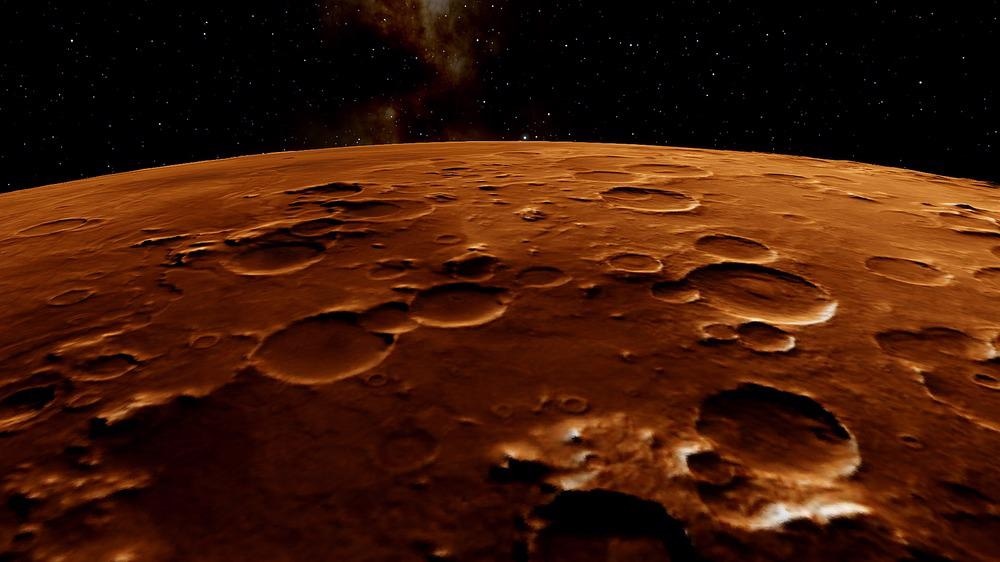The InSight mission is comprised of a range of cutting-edge sensors designed to learn more about the Red Planet than ever before. Shortly after its arrival on the surface of Mars InSight launcher discovered the first evidence of seismic activity. After nearly ten months of operations, the first results from InSight are revealed in a series of papers published across the Nature family of journals.

Image Credit: Lubo Ivanko/Shutterstock.com
Among the revelations contained within the papers was the detection of 20 ‘marsquakes’ of magnitude 3 to 4, and 174 further seismic events indicating volcanic and tectonic activity.
Together, these discoveries revealed that the Red Planet has seismic activity somewhere between Earth and Moon levels. The first findings from the mission also delivered a surprise in the form of detecting a local magnetic field at the landing site that is ten times stronger than expected.
The aim of the geophysical lander, which touched down on the Martian surface in 2018, is to investigate Mars’ deep interior for the first time. This includes the aforementioned seismic disturbances through the planet’s crust, mantle, and core, which have been termed ‘Marquakes.’
However, like that seismic activity itself, the mission of InSight runs much deeper than the detection of Marsquakes. By taking the “vital signs” of Mars, researchers hope to understand the formation of the rocky planets in the solar system as well as that of rocky exoplanets outside of our region of space. The adoption of sensor technology to achieve this is explored below.
NASA Mars InSight Overview
Video Credit: Nasa Jet Propulsion Laboratory/Shutterstock.com
What Insight Can be Gained from Mars Interior?
While Mars has geological structures and features that are similar to those of Earth, it has suffered less destructive natural events. Therefore, studying the interior of this planet can provide insight into planetary formations and their origin that might not be possible on Earth.
Though we now know that Mars does have seismic activity, it is much less geologically active than Earth. In particular, Mars lacks plate tectonics, which means that Mars retains a complete record of its geological history in its core, mantle, and crust.
These features are only present on Mars because it is of sufficient size to have undergone internal heating and differentiation. This mechanism separates inner layers while being small enough to have not experienced events that destroy early evidence of these geological processes.
InSight will examine the thickness, density, and structure of Mars’ interior in addition to measuring how heat escapes from the inner layers to the surface, thus getting a broader picture of planetary evolution for rocky planets.
SEIS: Taking the Pulse of Mars
One of the first tasks conducted by InSight was the use of the mission’s robotic arm to deploy the Seismic Experiment for Interior Structure (SEIS)on Mars’ surface, allowing InSight to begin detecting an expected 12 to 100 Marsquakes per year.
The sensor’s function extends beyond the detection of marsquakes. SEIS also monitors thumps made by the impact of asteroids and disturbances in Mars’ atmosphere and the weather conditions across the Martian surface.
As SEIS tracks seismic waves passing through Mars, it will build a picture of the composition of the crust, mantle, and even perhaps the core of the planet. The speed at which these waves travel makes this possible, as they reveal a great deal about the material they pass through.
The InSight research team monitor the SEIS results, closely searching for signs that areas 600 to 1200 miles from the landing site may have experienced volcanoes as recently as 1 to 10 million years ago. A change in seismic waves could indicate volcanic trenches laid down at that time.
RISE: Measuring Mars’ Reflexes
The Rotation and Interior Structure Experiment (RISE) comprised of two listening-antenna, can be used to listen to signals from passing orbiters to ascertain the lander's longitude and latitude. Doing so aided researchers in the early days to properly verify the lander's position on the Martian surface.
The RISE instrument's primary function is to listen for wobbles in Mars North-Pole as the Sun pushes and pulls its orbit using the doppler-shift and bunching of sound waves. Data obtained from these sensors will allow researchers to determine the planet's core's size, density, and composition—the pertinent question being whether it is liquid or solid iron.
To explain, InSight is looking for evidence that a liquid core once existed on Mars. Finding traces of this would suggest that Mars at some stage had a magnetosphere like Earth, protecting it from bombardments of charged particles from the Sun, known as solar winds.
As the magnetosphere on Earth has protected the planet's atmosphere from being stripped away by diverting these particles around the Earth, evidence of a Martian magnetosphere lends credibility to the idea that Mars could have once harbored life.
HP³: Taking the Temperature of Mars
InSight's Heat Flow and Physical Properties Probe (HP³) has successfully drilled down and penetrated the crater well's loose material despite initial concerns over missing the intended landing position.
A temperature probe, designed by a team from Germany, Poland, and the U.S., has been deployed into this drill hole. Burrowing 5 meters deep, the probe possesses a series of temperature sensors to uncover the amount of heat still flowing from the planet's core to its surface.
By measuring temperature changes, this sensor infused technology will help determine how effective a conductor Mars interior is, which may allow researchers to infer if the Red Planet was formed from the same elements as the Earth and the moon.

Image Credit AleksandrMorrisovich/Shutterstock.com
A Deeper InSight into Mars
Though InSight was the eighth probe that has landed on the surface of Mars, its multifunction ability makes it one of the most important. The fact that NASA has described InSight's experiments as taking the vitals of Mars serves as a reminder that with sensor technology, its history, composition, and ecosystem are being investigated much deeper than ever before.
Continue reading: How MEDLI’s Seven Sensors are Helping NASA’s Curiosity Rover's Long-Term Survival
References and Further Reading
Golombek, M., Warner, N.H., Grant, J.A. et al., (2020), Geology of the InSight landing site on Mars, Nat Commun 11, 1014. Available at: https://doi.org/10.1038/s41467-020-14679-
Banerdt, W.B., Smrekar, S.E., Banfield, D. et al., (2020), Initial results from the InSight mission on Mars, Nat. Geosci. 13, 183–189. Available at: https://doi.org/10.1038/s41561-020-0544-y
Banfield, D., Spiga, A., Newman, C. et al., (2020), The atmosphere of Mars as observed by InSight, Nat. Geosci. 13, 190–198. Available at: https://doi.org/10.1038/s41561-020-0534-0
Giardini, D., Lognonné, P., Banerdt, W.B. et al. (2020), The seismicity of Mars, Nat. Geosci. 13, 205–212. Available at: https://doi.org/10.1038/s41561-020-0539-8
Lognonné, P., Banerdt, W.B., Pike, W.T. et al, (2020), Constraints on the shallow elastic and anelastic structure of Mars from InSight seismic data, Nat. Geosci. 13, 213–220. Available at: https://doi.org/10.1038/s41561-020-0536-y
Golombek, M., Warner, N.H., Grant, J.A. et al. (2020), Geology of the InSight landing site on Mars. Nat Commun 11, 1014. Available at: https://doi.org/10.1038/s41467-020-14679-1
Jpl.nasa.gov. (2021) Science. [online] Available at: https://www.jpl.nasa.gov/news/press_kits/insight/launch/mission/science/#7
En.wikipedia.org. (2021) Subduction - Wikipedia. [online] Available at: https://en.wikipedia.org/wiki/Subduction
Disclaimer: The views expressed here are those of the author expressed in their private capacity and do not necessarily represent the views of AZoM.com Limited T/A AZoNetwork the owner and operator of this website. This disclaimer forms part of the Terms and conditions of use of this website.